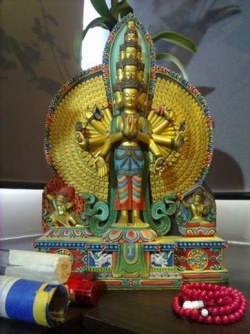Difference between revisions of "Tibetan Buddhist beliefs concerning Chenrezig"
| Line 1: | Line 1: | ||
[[File:0c-320wi.jpg|thumb|250px|]] | [[File:0c-320wi.jpg|thumb|250px|]] | ||
| − | [[Avalokiteśvara]] (known as '''[[Chenrezig]]''' in [[Tibetan language]] [[Tibetan]]) is an important [[deity]] in [[Tibetan Buddhism]], and is perhaps regarded as higher than a [[bodhisattva]], specifically as a [[Buddha]]. The [[Dalai Lama]] is considered by the [[Gelugpa]] sect and many other [[Tibetan]] [[Buddhists]] to be the [[primary]] [[earthly]] [[manifestation]] of [[Chenrezig]]. Other [[manifestations]] popular in [[Tibet]] include ''Sahasra-bhuja'' (a [[form]] with a thousand arms) and ''[[Ekādaśamukha]]'' (a [[form]] with eleven faces). In [[Tibetan Buddhism]], [[Tara]] ([[Devi]]) [[White Tara]] acts as the [[dakini]] [[consort]] and energizer of Avalokiteśvara/Chenrezig. According to popular [[belief]], [[Tara]] came into [[existence]] from a single tear shed by [[Chenrezig]]. When the tear fell to the ground it created a lake, and a [[lotus]] opening in the lake revealed [[Tara]]. In another version, [[Tara]] emerges from the [[heart]] of [[Chenrezig]]. In either version it is Chenrezig's outpouring of [[compassion]] which [[manifests]] [[Tara]] as a [[being]]. | + | |
| + | |||
| + | |||
| + | |||
| + | |||
| + | [[Avalokiteśvara]] (known as '''[[Chenrezig]]''' in [[Tibetan language]] [[Tibetan]]) is an important [[deity]] in [[Tibetan Buddhism]], and is perhaps regarded as higher than a [[bodhisattva]], specifically as a [[Buddha]]. The [[Dalai Lama]] is considered by the [[Gelugpa]] [[sect]] and many other [[Tibetan]] [[Buddhists]] | ||
| + | |||
| + | to be the [[primary]] [[earthly]] [[manifestation]] of [[Chenrezig]]. Other [[manifestations]] popular in [[Tibet]] include ''[[Sahasra-bhuja]]'' (a [[form]] with a thousand arms) and ''[[Ekādaśamukha]]'' (a [[form]] with eleven faces). In [[Tibetan Buddhism]], [[Tara]] ([[Devi]]) [[White Tara]] acts as the [[dakini]] | ||
| + | |||
| + | [[consort]] and energizer of Avalokiteśvara/Chenrezig. According to popular [[belief]], [[Tara]] came into [[existence]] from a single tear shed by | ||
| + | |||
| + | [[Chenrezig]]. When the tear fell to the ground it created a lake, and a [[lotus]] opening in the lake revealed [[Tara]]. In another version, [[Tara]] emerges from the [[heart]] of [[Chenrezig]]. In either version it is [[Chenrezig's]] outpouring of [[compassion]] which [[manifests]] [[Tara]] as a [[being]]. | ||
| + | |||
| + | |||
{{R}} | {{R}} | ||
[http://www.mauspfeil.net/Avalokite%C5%9Bvara.html www.mauspfeil.net] | [http://www.mauspfeil.net/Avalokite%C5%9Bvara.html www.mauspfeil.net] | ||
[[Category:Buddhist Terms]] | [[Category:Buddhist Terms]] | ||
[[Category:Avalokiteshvara]] | [[Category:Avalokiteshvara]] | ||
Latest revision as of 08:03, 24 November 2020
Avalokiteśvara (known as Chenrezig in Tibetan language Tibetan) is an important deity in Tibetan Buddhism, and is perhaps regarded as higher than a bodhisattva, specifically as a Buddha. The Dalai Lama is considered by the Gelugpa sect and many other Tibetan Buddhists
to be the primary earthly manifestation of Chenrezig. Other manifestations popular in Tibet include Sahasra-bhuja (a form with a thousand arms) and Ekādaśamukha (a form with eleven faces). In Tibetan Buddhism, Tara (Devi) White Tara acts as the dakini
consort and energizer of Avalokiteśvara/Chenrezig. According to popular belief, Tara came into existence from a single tear shed by
Chenrezig. When the tear fell to the ground it created a lake, and a lotus opening in the lake revealed Tara. In another version, Tara emerges from the heart of Chenrezig. In either version it is Chenrezig's outpouring of compassion which manifests Tara as a being.
